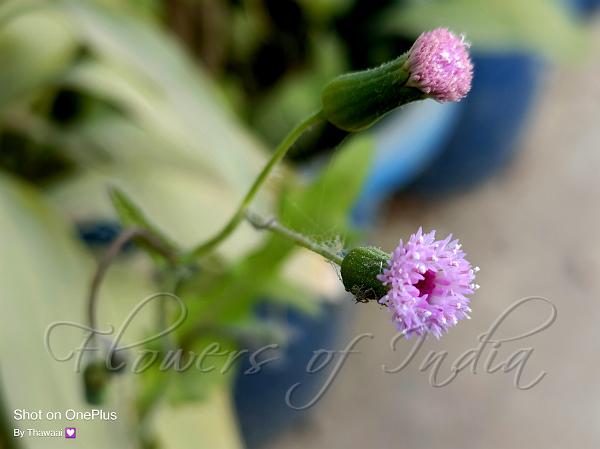|
| Purple Sow Thistle |
|

|

| File size | 441072 |
| Original date | 11/17/22 11:47 AM |
| Resolution | 4624 x 3468 |
| Flash | Flash did not fire, auto |
| Focal length | 4.73mm |
| Exposure time | 1/101s |
| Aperture | 1.7 |
| Focus Distance | |
| Metering Mode | Center weighted average |
| Camera make | OnePlus |
| Camera model | OnePlus Nord CE 2 |
| Sensor type | Undefined |
|
|
|
|
Photo: |
Botanical name: Emilia sonchifolia Family: Asteraceae (Sunflower family)
Synonyms: Emilia sinica, Senecio rapae, Crassocephalum sonchifolium
Synonyms: Emilia sinica, Senecio rapae, Crassocephalum sonchifolium
Purple Sow Thistle is an annual herb with a branched taproot. Stems are
weak, erect or often branched at the base, smooth or sparingly hairy, 10
to 60 cm tall. This species is recognized by the
sow-thistle like leaves. Lower leaves are
deeply and irregularly toothed, kidney-shaped, ovate, triangular-ovate or
obovate, 4-16 cm long, 1-8 cm wide with narrowly winged stalks. Upper
leaves are smaller, alternately arranged, usually entire, sometimes
coarsely toothed, stalkless and somewhat clasping the main stem.
Inflorescence is an involucrate flower head resembling a single flower,
1.2-1.4 cm long, 4-5 mm wide, urn-shaped, long-stalked, at the end of
branches. Flowering branches usually dichotomously branched with 3-6
heads, each head or capitulum a composite of numerous florets. The cup of
the flower-head is green, cylindrical, somewhat inflated below. Florets
are 30-60 per head, purple, scarlet, red, pink, orange, white or lilac.
Purple Sow Thistle is found in the Himalayas, up to altitudes of 2100 m.
Medicinal uses: It is one of the most commonly used plants in Manipur. Its main uses are in stomach complaints.
Fresh leaves are eaten raw with Ametpa (alocal delicacy prepared with chilies and
fermented small fishes called Ngari) for 5-6 days. Three or four leaves are eaten daily
in this manner.
It is one of the most commonly used plants in Manipur. Its main uses are in stomach complaints.
Fresh leaves are eaten raw with Ametpa (alocal delicacy prepared with chilies and
fermented small fishes called Ngari) for 5-6 days. Three or four leaves are eaten daily
in this manner.
Medicinal uses:
 It is one of the most commonly used plants in Manipur. Its main uses are in stomach complaints.
Fresh leaves are eaten raw with Ametpa (alocal delicacy prepared with chilies and
fermented small fishes called Ngari) for 5-6 days. Three or four leaves are eaten daily
in this manner.
It is one of the most commonly used plants in Manipur. Its main uses are in stomach complaints.
Fresh leaves are eaten raw with Ametpa (alocal delicacy prepared with chilies and
fermented small fishes called Ngari) for 5-6 days. Three or four leaves are eaten daily
in this manner.
| Identification credit: Navendu Pāgé | Photographed in Imphal, Manipur & JNCASR, Bangalore. |
• Is this flower misidentified? If yes,